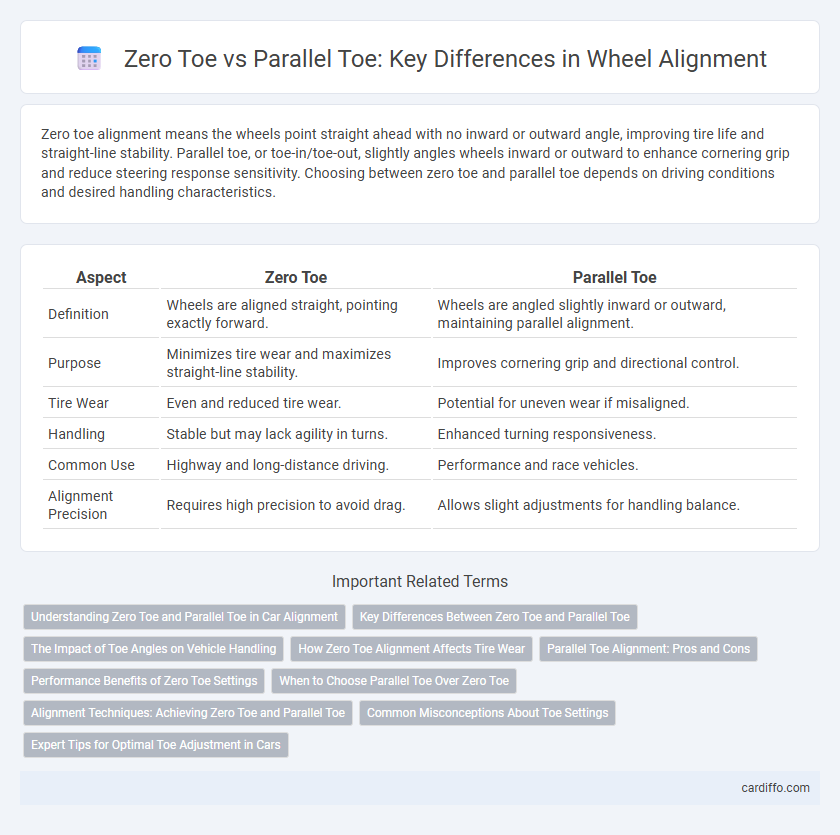Zero toe alignment means the wheels point straight ahead with no inward or outward angle, improving tire life and straight-line stability. Parallel toe, or toe-in/toe-out, slightly angles wheels inward or outward to enhance cornering grip and reduce steering response sensitivity. Choosing between zero toe and parallel toe depends on driving conditions and desired handling characteristics.
Table of Comparison
| Aspect | Zero Toe | Parallel Toe |
|---|---|---|
| Definition | Wheels are aligned straight, pointing exactly forward. | Wheels are angled slightly inward or outward, maintaining parallel alignment. |
| Purpose | Minimizes tire wear and maximizes straight-line stability. | Improves cornering grip and directional control. |
| Tire Wear | Even and reduced tire wear. | Potential for uneven wear if misaligned. |
| Handling | Stable but may lack agility in turns. | Enhanced turning responsiveness. |
| Common Use | Highway and long-distance driving. | Performance and race vehicles. |
| Alignment Precision | Requires high precision to avoid drag. | Allows slight adjustments for handling balance. |
Understanding Zero Toe and Parallel Toe in Car Alignment
Zero toe in car alignment means the wheels are pointed straight ahead, parallel to the vehicle's centerline, which promotes even tire wear and stable handling. Parallel toe occurs when both wheels on an axle are aligned equally inward (toe-in) or outward (toe-out), enhancing cornering performance and vehicle stability. Proper adjustment between zero toe and parallel toe settings depends on driving style and vehicle specifications for optimal tire life and handling dynamics.
Key Differences Between Zero Toe and Parallel Toe
Zero toe alignment features wheels pointing straight ahead for minimal tire scrub and optimized fuel efficiency, while parallel toe involves wheels angled slightly inward or outward to enhance cornering stability and reduce tire wear. Zero toe reduces rolling resistance and promotes even tread wear, making it ideal for fuel economy and highway driving. Parallel toe settings improve handling precision and grip but may increase tire wear if not properly adjusted.
The Impact of Toe Angles on Vehicle Handling
Zero toe alignment positions the tires so they point straight ahead, maximizing straight-line stability and reducing tire wear during normal driving conditions. Parallel toe, where tires are angled slightly inward or outward yet maintain parallelism, enhances cornering precision by improving tire contact with the road during turns. Variations in toe angles critically affect vehicle handling dynamics, influencing steering responsiveness, tire traction, and overall driving safety.
How Zero Toe Alignment Affects Tire Wear
Zero toe alignment maintains tires perfectly parallel to the vehicle's centerline, minimizing irregular tire wear by ensuring even contact with the road. This alignment reduces lateral scrubbing and prevents accelerated wear on the inner or outer edges of the tires. Proper zero toe settings extend tire life and enhance handling stability by promoting uniform tread engagement.
Parallel Toe Alignment: Pros and Cons
Parallel toe alignment maintains equal toe angles on both wheels, promoting even tire wear and improved straight-line stability. This setup enhances handling precision during high-speed driving but may reduce steering responsiveness in tight turns. Despite better tire longevity, parallel toe can sometimes result in less agile maneuvering compared to zero toe alignment.
Performance Benefits of Zero Toe Settings
Zero toe alignment minimizes tire scrub and rolling resistance, enhancing straight-line stability and improving fuel efficiency. This setting promotes even tire wear, leading to longer tire lifespan and consistent grip during high-speed maneuvers. Athletes and performance drivers benefit from precise steering response and reduced drivetrain stress with zero toe configurations.
When to Choose Parallel Toe Over Zero Toe
Parallel toe alignment is preferable over zero toe when vehicle stability and tire wear distribution require optimization, particularly in high-performance or front-wheel-drive cars. Parallel toe, where both wheels point slightly outward or inward equally, enhances cornering precision and reduces uneven tire degradation compared to zero toe's neutral position. This setup is ideal for drivers seeking improved handling responsiveness without sacrificing straight-line stability.
Alignment Techniques: Achieving Zero Toe and Parallel Toe
Alignment techniques for achieving zero toe focus on positioning the wheels so they are perfectly parallel to the vehicle's longitudinal axis, minimizing tire wear and enhancing straight-line stability. Parallel toe settings involve aligning the front and rear wheels so they are parallel to each other, optimizing handling and steering response during cornering. Advanced alignment tools use laser measurements and computer sensors to ensure precise zero toe and parallel toe adjustments, improving overall vehicle performance and safety.
Common Misconceptions About Toe Settings
Zero toe and parallel toe are often misunderstood as identical toe alignment settings, yet zero toe means wheels point straight ahead, while parallel toe indicates both front and rear wheels are aligned equally, potentially with slight toe-in or toe-out. A common misconception is that zero toe guarantees optimal handling, but slight toe adjustments can enhance stability and tire wear depending on vehicle dynamics. Understanding precise toe specifications tailored to the vehicle model improves alignment accuracy and driving performance.
Expert Tips for Optimal Toe Adjustment in Cars
Expert tips for optimal toe adjustment emphasize understanding the differences between zero toe and parallel toe settings. Zero toe aligns the wheels so they point straight ahead, reducing uneven tire wear and improving straight-line stability, while parallel toe involves slight inward or outward angles for enhanced cornering performance and vehicle responsiveness. Precise measurement with alignment tools and regular checks ensure that toe settings match manufacturer specifications, maximizing tire lifespan and driving safety.
Zero toe vs Parallel toe Infographic

 cardiffo.com
cardiffo.com